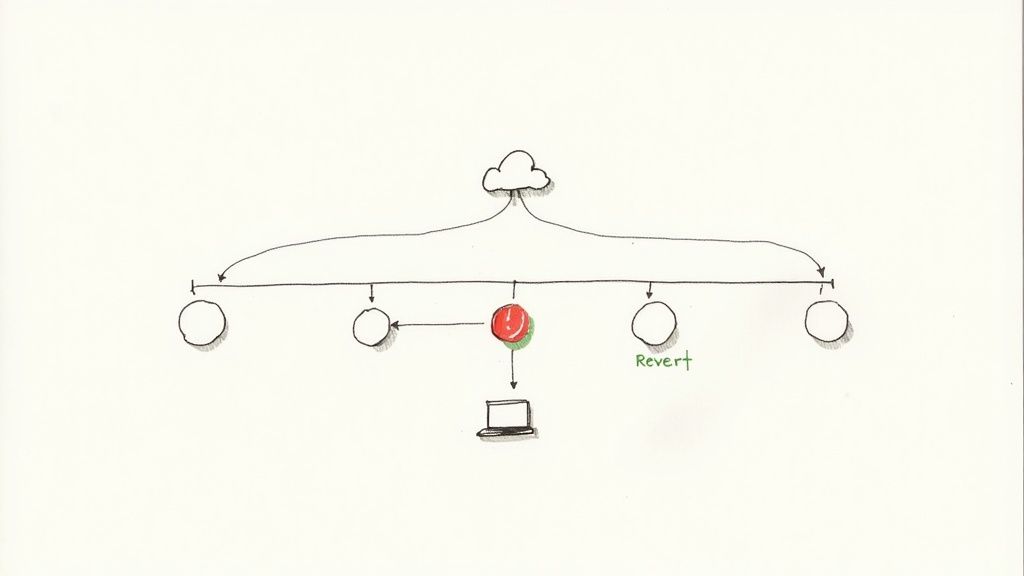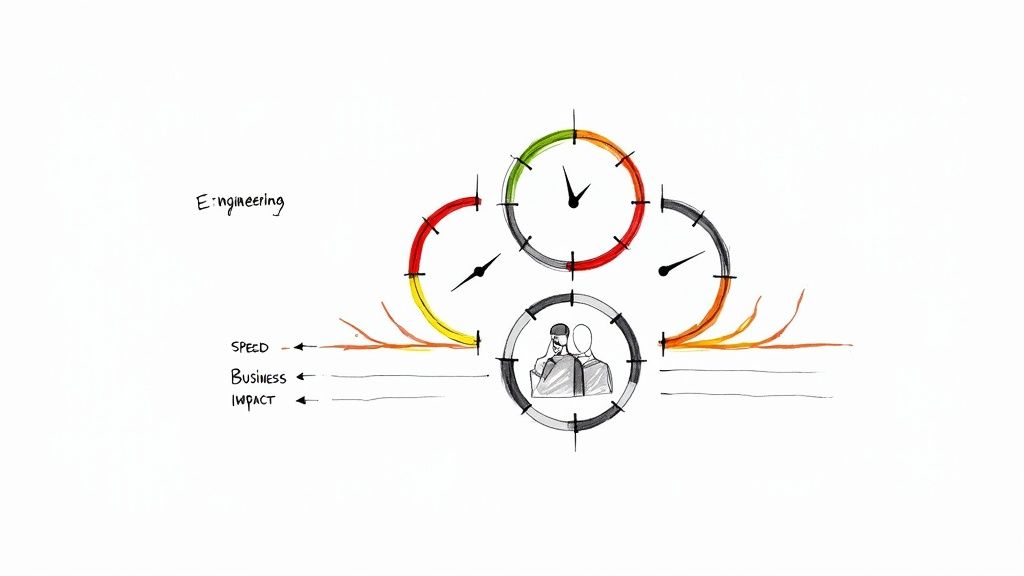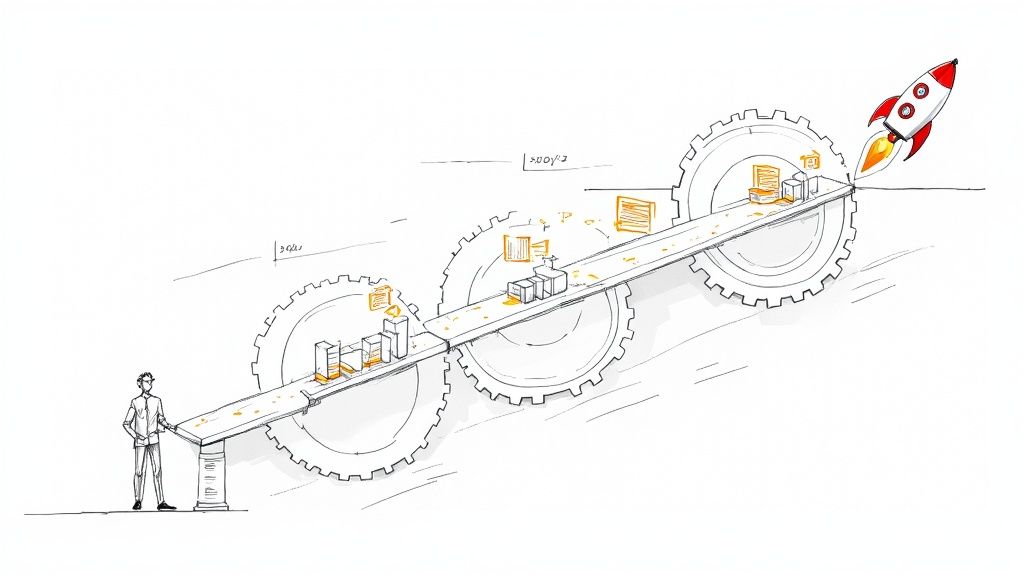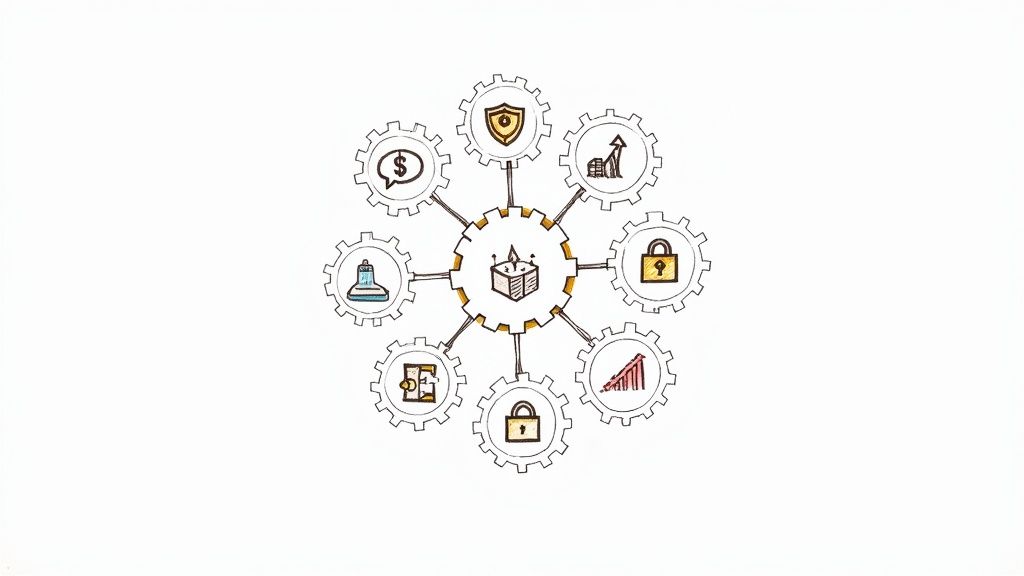10 Real-World CI CD Pipeline Examples That Drive DevOps Success

Mastering Modern CI/CD Pipeline Fundamentals
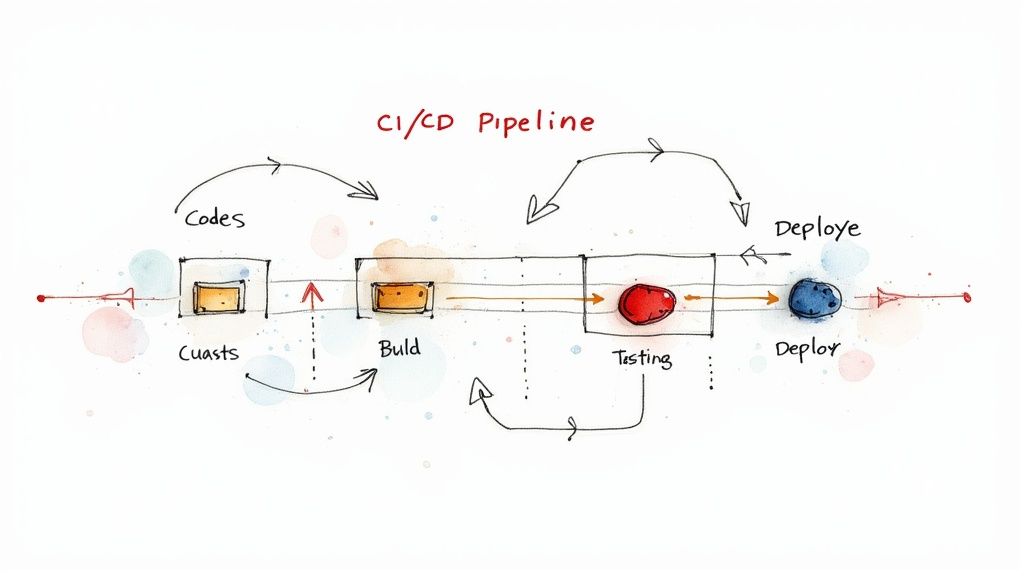
Software teams increasingly rely on CI/CD pipelines to deliver code faster and more reliably. While about half of development teams use either Continuous Integration (CI) or Continuous Deployment (CD), only around 18% successfully combine both into a fully automated workflow. This gap shows that many teams still need to master the core principles of building effective CI/CD pipelines.
Understanding The Core Components Of A CI/CD Pipeline
Like any well-designed system, a CI/CD pipeline consists of essential parts working together to automate code delivery from commit to deployment. The main components include:
- Source Code Management: This initial stage uses platforms like Git to track code changes and start the pipeline process.
- Build Automation: Here, the code and dependencies are compiled into executable files. Common tools include Maven and Gradle, with many teams also building Docker containers for cloud applications.
- Testing: Automated tests check code quality through unit tests, integration tests, and end-to-end tests.
- Deployment: The final stage automatically releases software to staging and production environments, often using tools like Kubernetes and Ansible.
Building Robust Pipelines: Practical Approaches
Creating a strong CI/CD pipeline requires careful planning and focus on key areas:
- Automation: Remove manual steps throughout the process to reduce errors and maintain consistency.
- Testing: Build comprehensive automated test suites to catch issues early.
- Monitoring and Feedback: Add monitoring tools that track performance and give developers quick feedback.
- Version Control: Use proper version control practices to manage changes and enable easy rollbacks when needed.
CI/CD Pipelines in Different Contexts
Organizations implement CI/CD differently based on their size and needs. Large enterprises, with bigger teams and complex projects, show higher adoption rates around 60%. However, only about 10% of their applications achieve full CI/CD integration, showing that mastering these practices takes time. Meanwhile, about 48% of smaller organizations use CI/CD but often struggle with limited resources and expertise.
These varying adoption rates show why teams need CI/CD approaches suited to their specific situation. For example, startups often build simpler pipelines focused on quick delivery, while enterprises emphasize security and compliance requirements. But regardless of size, success comes from understanding core concepts and following proven practices. When teams master these fundamentals, they can significantly improve how they deliver software.
Enterprise-Grade Pipeline Implementation Strategies

Large organizations face unique challenges when implementing CI/CD pipelines due to their size and complexity. With multiple applications, services, and interconnected systems to manage, these organizations need carefully planned automation and deployment strategies. Research shows this focused approach pays off - enterprises achieve CI/CD adoption rates around 60% compared to 48% in smaller companies. Let's explore how successful organizations build and manage these systems at scale.
Handling Complex Deployment Scenarios
When deploying across various environments - from on-premise servers to cloud platforms - enterprise pipelines need robust orchestration capabilities. Teams must coordinate releases across different locations while maintaining consistent configurations. Many organizations use Infrastructure as Code tools to automate and standardize their infrastructure setup. They also implement advanced deployment patterns like blue-green deployments or canary releases to reduce risks and minimize system downtime during updates.
Managing Multiple Environments and Teams
In large companies, different teams often work simultaneously on various parts of an application ecosystem. This requires careful coordination between groups to ensure smooth integration and deployment processes. Common approaches include using shared code repositories, clear branching strategies, and automated merge processes. Teams also need proper access controls and permissions within the pipeline to maintain security standards and compliance requirements.
Maintaining Consistency Across Large-Scale Operations
For enterprise CI/CD to work effectively, organizations need consistent tools, processes and configurations across all teams. Many companies establish a dedicated platform engineering team to develop and maintain shared pipeline templates, reusable code libraries, and standard tool sets. This approach helps streamline development while promoting best practices. Comprehensive monitoring and centralized logging are also essential for maintaining visibility across the entire pipeline.
CI/CD Pipeline Example: Enterprise-Level Implementation
Consider how a large e-commerce company might structure their pipeline for a complex web application with microservices, databases and third-party integrations:
| Stage | Description | Tools (Examples) |
|---|---|---|
| Code Commit | Developers commit code changes to a shared repository. | Git, GitHub Enterprise |
| Build | Automated build process compiles code and packages it into artifacts. | Maven, Gradle, Docker |
| Test | Unit, integration, and end-to-end tests are executed. | JUnit, Selenium, pytest |
| Staging | Deployment to a staging environment for further testing and validation. | Kubernetes, Ansible |
| Security Scan | Automated security checks and vulnerability scanning. | Snyk, SonarQube |
| Production | Deployment to production environment using blue/green or canary release. | Kubernetes, Spinnaker |
| Monitoring | Continuous monitoring of application performance and health. | Prometheus, Grafana |
This example shows how different tools and techniques come together in a complete workflow that handles enterprise-scale deployments. While these pipelines require careful planning and maintenance, they give large organizations the speed and reliability needed to deliver software effectively, even with complex applications and multiple development teams.
Building Security-First CI/CD Pipelines
Building Security-First CI/CD Pipelines
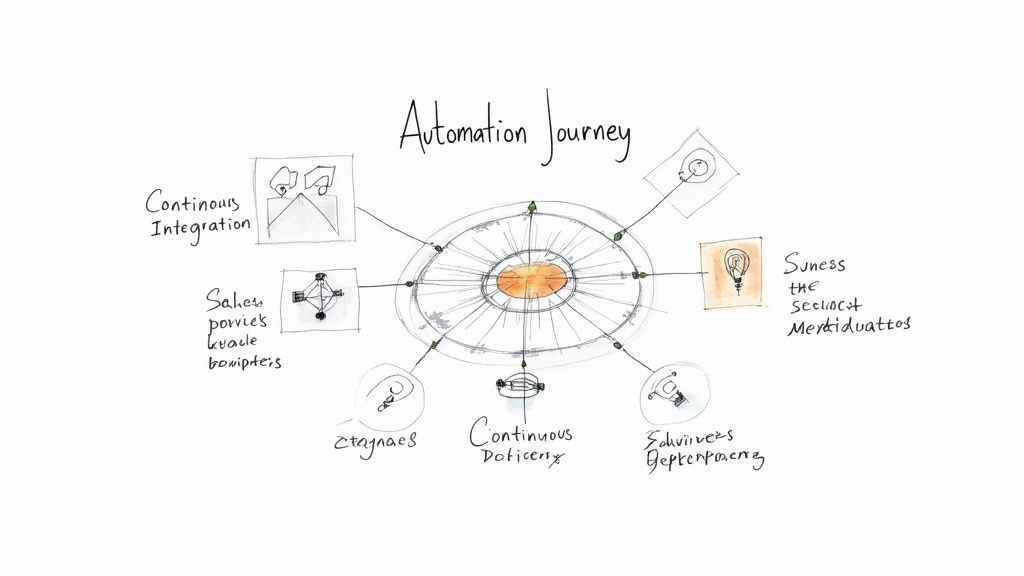
Security needs to be woven into every aspect of CI/CD pipelines from the start - not added as an afterthought. With enterprise CI/CD adoption reaching 60% but only 10% of applications fully using these practices, there's both opportunity and risk. The expanding usage creates more potential vulnerabilities, making it critical to build security directly into automated workflows without slowing down delivery. Let's explore practical ways to create CI/CD pipelines that prioritize security while maintaining speed.
Integrating Security at Each Stage
Building secure pipelines requires implementing checks across every phase, starting with secure coding practices and extending through deployment and monitoring. During code commits, teams can use Static Application Security Testing (SAST) tools to catch vulnerabilities in source code. Software composition analysis tools check open-source dependencies for known issues - especially important since most modern applications heavily use third-party components.
The build stage presents another key security checkpoint. For containerized apps, image scanning identifies vulnerabilities in both application dependencies and base images before they reach production. Teams should also implement secrets management to securely handle sensitive data like API keys and database credentials, rather than embedding them in code where they could be exposed.
Implementing Security Testing and Vulnerability Scanning
Beyond standard functional testing, security testing is essential. Dynamic Application Security Testing (DAST) simulates real attacks against running applications in staging environments, often finding issues that static analysis misses - like problems with authentication, authorization and input validation. Since thorough security scans take time, teams need to carefully choose which tools and tests make sense for their specific needs.
Ongoing vulnerability scanning throughout the pipeline helps catch new issues as they emerge. By automating these scans and making them part of standard workflows, security stays top of mind. The challenge becomes managing all the findings effectively. A structured vulnerability management process helps teams prioritize fixes, focusing first on the most critical issues that could put systems at risk.
Secure Artifact Management and Deployment
After passing security tests, application artifacts need proper protection. This means storing them in secured repositories and controlling who can access and deploy them - particularly important for large enterprises with multiple teams. Digital signing of artifacts prevents tampering by verifying their integrity and authenticity before deployment.
The final stage requires runtime security monitoring and intrusion detection to identify threats in production. These tools complement earlier pipeline security measures by providing active protection of live systems. By implementing security at each phase, organizations can confidently automate their delivery while managing risk. This comprehensive approach allows teams to ship software quickly without compromising on safety - addressing both the opportunities and challenges that widespread CI/CD adoption brings.
Startup Success Stories: Lean CI/CD Implementation

While major companies achieve CI/CD adoption rates of around 60%, smaller teams can still implement effective pipelines despite limited resources. Research shows that nearly half of small companies successfully use CI/CD, proving that budget constraints don't have to be a barrier. With smart planning and the right tools, startups can build efficient delivery pipelines that help them stay competitive.
Building a Minimum Viable Pipeline
For new companies getting started with CI/CD, the key is starting small with essential automation. Rather than trying to replicate complex enterprise setups, focus first on automating core steps like builds, tests, and deployment to a single environment. This focused approach lets teams quickly see real benefits - faster feedback on code changes and quicker releases - without a big upfront investment. As the company grows, teams can gradually add more advanced capabilities to their pipeline.
Leveraging Open-Source and Cloud-Based Tools
The open-source community offers excellent CI/CD tools that are perfect for cost-conscious teams. Jenkins, GitLab CI, and Drone CI provide robust features without licensing fees. Cloud platforms like AWS, Azure, and Google Cloud also offer CI/CD services with flexible pricing based on actual usage. This means startups can access enterprise-grade infrastructure without managing their own hardware.
CI/CD Pipeline Examples: Startup Implementations
Here are some real-world examples of CI/CD pipelines built by startups:
- Example 1: SaaS Startup using Serverless Architecture: A team building serverless apps set up direct integration between their code repository and cloud platform. When developers push changes, the pipeline automatically builds and deploys to the serverless environment.
- Example 2: Mobile App Development: A mobile startup uses cloud-based CI/CD to automate their app builds, run tests, and distribute new versions to testers. This removes manual work from the release process.
- Example 3: E-commerce Platform: An online store's pipeline automatically deploys website updates after testing, helping them quickly roll out improvements to their shopping experience.
Scaling With Growth: Expanding the CI/CD Pipeline
As startups grow, their delivery pipeline needs to grow with them. Teams can gradually add security checks, performance testing, and more sophisticated deployment strategies. A well-designed pipeline, even a simple one, also helps attract skilled developers who value modern practices. The key is building a foundation that can evolve alongside your company while maintaining speed and quality at every stage.
Overcoming Pipeline Implementation Roadblocks
Implementing a successful CI/CD pipeline presents real challenges that go beyond just selecting tools. While many organizations say they use CI/CD, industry data shows only about 10% of applications fully use these practices. This gap between adoption and actual implementation highlights the common hurdles teams face. Let's explore practical ways to overcome these challenges.
Identifying and Addressing Technical Hurdles
Setting up and maintaining a CI/CD pipeline comes with significant technical complexity. Teams often struggle to connect different tools, handle dependencies properly, and set up reliable automated tests. Moving legacy applications to CI/CD workflows can be especially difficult when dealing with older code that lacks proper test coverage.
The key is starting with a clear plan. First, thoroughly review your current systems and tools to spot areas that need improvement. Focus initially on automating your most important and time-consuming tasks - whether that's build processes, unit testing, or staging deployments. Consider testing your pipeline setup with a smaller application first before rolling it out widely. This approach lets you learn and adjust without disrupting critical systems.
Navigating Organizational Resistance to Change
While technical challenges are significant, organizational culture often determines CI/CD success. Teams frequently face resistance from stakeholders, siloed departments, and general reluctance to change established practices. The solution starts with clear communication about concrete benefits - faster delivery times, lower deployment risks, and better software quality.
Share specific examples of how other companies have successfully implemented CI/CD and the positive results they've achieved. Work to build collaboration between development, operations and security teams through cross-functional groups and shared goals. Set up regular communication channels and measure progress with metrics that matter to all teams involved. Breaking down barriers between teams and creating shared ownership helps overcome resistance and builds lasting positive change.
Simplifying Automation Complexities
While automation is essential to CI/CD, overly complex automated processes can create more problems than they solve. Teams can get stuck managing complicated workflows, juggling too many tools, and debugging intricate scripts. The solution is to start small and build gradually.
Begin by automating basic but critical tasks. Create modular, reusable components for common needs like building Docker images, running security scans, or deploying to Kubernetes. Make these components easy to maintain and combine. This approach reduces complexity and lets teams focus on delivering value rather than managing automation overhead.
Measuring Success and Continuous Improvement
To sustain long-term success, track clear metrics that show how well your pipeline performs. Key measurements include how often you deploy, how long changes take to implement, failure rates during deployment, and how quickly you can fix issues when they occur. Review these metrics regularly with your teams to spot bottlenecks and opportunities for improvement.
Get frequent feedback from everyone using the pipeline about what's working and what isn't. Use this input to refine your processes and tools over time. By staying focused on steady improvement and adapting as needs change, you can work through implementation challenges and get the full benefits of CI/CD practices.
Future-Proofing Your Pipeline Architecture
Creating an adaptable CI/CD pipeline is essential as your organization grows and changes. While a basic pipeline may work initially, it can become a constraint that slows down development and delivery over time. Building pipeline architecture that can evolve is crucial for maintaining speed and efficiency as your needs change.
Embracing Scalability and Flexibility
Your CI/CD pipeline needs to grow smoothly with your organization. Whether you're expanding from 10 to 100 engineers or handling increasingly complex projects, the pipeline architecture must scale effectively. Breaking down your pipeline into microservices is one approach that enables individual components to scale independently. This modular design provides more resilience than a monolithic pipeline that has to scale as a single unit.
Smart resource management is also key. Your pipeline should automatically adjust computing resources based on demand - allocating more during peak times and scaling down during quiet periods. Tools like cloud-based CI/CD services and Kubernetes make this dynamic scaling possible without manual intervention.
Integrating Emerging Technologies
New tools and approaches for improving CI/CD processes emerge regularly. Rather than requiring major rewrites to adopt these improvements, your pipeline should have clear interfaces that allow you to swap components easily. For example, if you find a better security scanning tool, you should be able to integrate it without disrupting other pipeline stages.
Consider using serverless computing for specific pipeline tasks like testing and deployment. Serverless functions can handle these workloads efficiently while reducing infrastructure management overhead. This lets you focus on optimizing the core pipeline logic rather than maintaining servers.
Maintaining Pipeline Efficiency and Observability
As pipelines grow more sophisticated, keeping them efficient and observable becomes critical. Without proper monitoring, a complex pipeline can become difficult to troubleshoot and improve. Implement detailed logging and metrics collection at each stage to track key indicators like stage duration, deployment success rates, and test failure patterns. This data helps identify bottlenecks and opportunities for optimization.
Clear documentation and communication are equally important. As teams expand, having easily accessible guides that explain the pipeline architecture, processes, and troubleshooting steps ensures everyone can effectively use and maintain the system.
Mergify helps address these scaling and integration challenges by providing robust merge workflow automation. By streamlining how code changes are merged, Mergify reduces bottlenecks and saves developer time, supporting an efficient and adaptable pipeline. Learn more about optimizing your CI/CD workflow at https://mergify.com.


